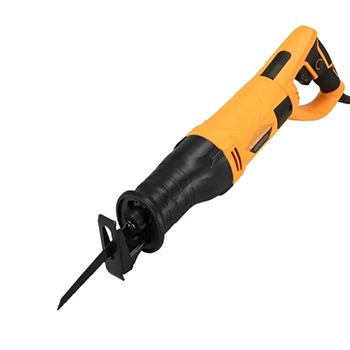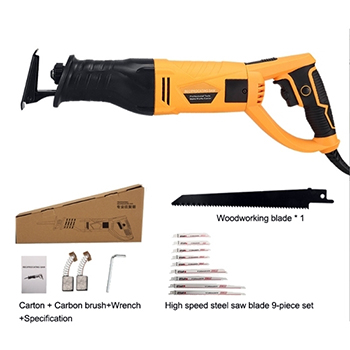How to Use Reciprocating Saw?
An electric reciprocating saw is a tool that is driven by a motor and used to cut various materials through the reciprocating and swinging actions of the saw blade. It is faster and less labor-intensive than the manual saws that people use every day. So do you know how to operate an electric reciprocating saw? Next, ATO will bring you the use and maintenance methods of electric reciprocating saws, hoping to be helpful to you.
How to operate a reciprocating saw?
Check whether the lubricating part, cooling part, and vise are normal before use. The assembly of the sawed material should be firm, and the assembly of multiple pieces should be checked to see if they are all fastened. If the material to be sawed has a large bend, it should not be assembled in multiple pieces and should be assembled firmly in a single piece before cutting.
Before starting the machine, you should first check whether the equipment circuit is normal, and the motor can only be ready to start when the motor is in a normal state. Choose the saw blade correctly, and the saw blade must not have cracks. Then check the tightness of the saw blade. If it is too loose, the saw blade will fall off, and if it is too tight, the saw blade will be broken. After confirming that the machine is normal, it is ready to start.
Turn on the power to adjust the speed of the chainsaw (adjust the speed of the chainsaw according to the material), and wait for the chainsaw to run normally for 3 to 5 minutes before cutting the material. During the cutting process, the material must be laid flat and straightened. The speed of the chainsaw should be appropriate, so as not to break the saw blade and cause the saw blade to hurt people.
Materials with too high hardness should be sawed after annealing. If the saw blade is skewed, it should be corrected in time. The saw bow should be tight enough to prevent breakage. If the saw blade breaks halfway, turn off the power before replacing it, and turn the workpiece over to make a new saw edge. When using the saw blade, cover the protective cover well, and keep your head and hands away from the running saw blade.
Choose a high-quality reciprocating saw blade because the saw blade plays a key role as an important consumable accessory for the saw machine. Proper operation and adjustment are important factors in extending the life of a reciprocating saw blade. To choose a saw blade suitable for cutting materials, the width, tooth shape, and pitch of the saw blade are also very important factors. The gear adjustment of the cutting speed, the size of the pressure, and the operating habits of the operator are all very important factors.
Proper and correct use of cutting fluid. The reciprocating saw blade generally does not need to use cutting fluid when cutting wood and plastic, which are generally soft materials, but if it is cutting hard and easy-to-heat materials such as metal, it needs to add cutting fluid.
Reciprocating Saw Maintenance
- The lifting guide rail of the main saw needs to be lubricated.
- Clean the main saw.
- Clean and lubricate the rails: After turning off the power, the main saw stops, then clean the guide rail, and wipe the lubricating oil with an oilcloth. Use an appropriate amount of lubricating oil to wipe the guide rails before starting the machine every day.
- Lubrication of the operating table: After turning off the power, clean, wipe, and lubricate the operating table with a cloth.
- Clean the suction channel: use compressed air to clean the dust.
- Pneumatic triple unit: clean the filter element and add pneumatic oil.
- Choose the right saw blade: choose the right saw blade according to the type and thickness of the material to be cut. Generally speaking, the more teeth the saw blade has, the better the cut quality will be, but the cutting speed will be slower.
- Adjust the depth of the knife edge: adjust the depth of the knife edge to a little more than the thickness of the material to ensure cutting quality and safety.
- Positioning the material: fix the material to be cut to ensure that the material will not slide or move.
- Pay attention to safety when operating the reciprocating saw, and keep your hands and clothing away from the saw blade to avoid danger. During operation, the position and trajectory of the reciprocating saw must be well-controlled to ensure cutting quality and efficiency.
How to install the saw blade lock of the reciprocating saw?
When assembling, make sure that the arrow direction of the saw blade is consistent with the rotation direction of the main shaft of the equipment. When installing the saw blade, keep the shaft center, the chuck, and the flange clean. The inner diameter of the flange is consistent with the inner diameter of the saw blade to ensure that the flange and the saw blade are tightly combined. Install the positioning pin and tighten the nut.
The size of the flange should be appropriate, and the outer diameter should not be less than one-third of the diameter of the saw blade. Before starting the equipment, under the condition of ensuring safety, there is a single person to operate the equipment. Check whether the equipment is turning correctly, whether there is vibration, and whether the saw blade is idling for a few minutes after it is installed, and it works normally without slipping, swinging, or beating.
Application
Make a hole in the wall
A reciprocating saw is highly recommended when you want to install a switch panel, especially if the area has multiple angles.
Replacement of PVC pipes
PVC can be easily cut with a reciprocating saw. PVC pipe is often located in places that ordinary saws cannot reach, so there is usually nothing more effective than a reciprocating saw when modifying pipe.
Cutting nails
When you have tough nails to remove, try a reciprocating saw.
Cutting branches
If you need to trim branches, a reciprocating saw is arguably the perfect tool for the job because of its durability and cutting ability to fully handle the job.
Install windows
This handy tool is also what professionals use to cut or install windows because it can work in those tight and uncomfortable spots with ease.
Cutting different materials
The reciprocating saw can cut different materials, and the scope of application is very flexible. It can cut almost any material, such as wood, PVC, and even metal.

